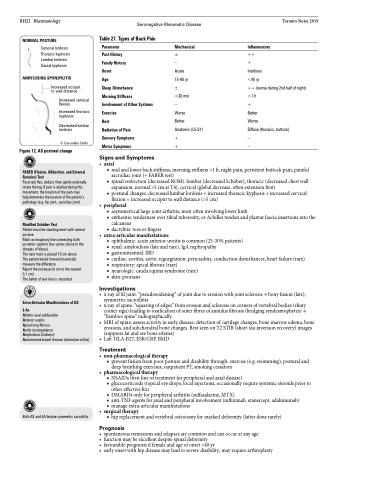Page 1308 - TNFlipTest
P. 1308
RH22 Rheumatology
Seronegative Rheumatic Disease
Toronto Notes 2019
NORMAL POSTURE
Cervical lordosis Thoracic kyphosis Lumbar lordosis Sacral kyphosis
ANKYLOSING SPONDYLITIS
Increased occiput to wall distance
Increased cervical flexion
Increased thoracic kyphosis
Decreased lumbar lordosis
© Cassandra Cetlin
Figure 12. AS postural change
FABER (Flexion, ABduction, and External Rotation) Test
Passively flex, abduct, then gently externally rotate the leg. If pain is elicited during this movement, the location of the pain may help determine the location of the patient’s pathology (e.g. hip joint, sacroiliac joint)
Modified Schöber Test
Patient must be standing erect with normal posture
Mark an imaginary line connecting both posterior superior iliac spines (close to the dimples of Venus)
The next mark is placed 10 cm above The patient bends forward maximally: measure the difference
Report the increase (in cm to the nearest 0.1 cm)
The better of two tries is recorded
Extra-Articular Manifestations of AS
6As
Atlanto-axial subluxation
Anterior uveitis
Apical lung fibrosis
Aortic incompetence
Amyloidosis (kidneys)
Autoimmune bowel disease (ulcerative colitis)
Table 27. Types of Back Pain
Parameter
Past History Family History Onset
Age
Sleep Disturbance
Morning Stiffness Involvement of Other Systems Exercise
Rest
Radiation of Pain
Sensory Symptoms
Motor Symptoms
Signs and Symptoms
Mechanical
±
–
Acute
15-90 yr
±
<30 min
–
Worse
Better
Anatomic (L5-S1) +
+
Inflammatory
++
+
Insidious
<45 yr
++ (worse during 2nd half of night) >1 h
+
Better
Worse
Diffuse (thoracic, buttock) –
–
Both AS and EA feature symmetric sacroiliitis
• axial
■ mid and lower back stiffness, morning stiffness >1 h, night pain, persistent buttock pain, painful
sacroiliac joint (+ FABER test)
■ spinal restriction (decreased ROM): lumbar (decreased Schöber), thoracic (decreased chest wall
expansion, normal >5 cm at T4), cervical (global decrease, often extension first)
■ postural changes: decreased lumbar lordosis + increased thoracic kyphosis + increased cervical
flexion = increased occiput to wall distance (>5 cm) • peripheral
■ asymmetrical large joint arthritis, most often involving lower limb
■ enthesitis: tenderness over tibial tuberosity, or Achilles tendon and plantar fascia insertions into the
calcaneus
■ dactylitis: toes or fingers
• extra-articularmanifestations
■ ophthalmic: acute anterior uveitis is common (25-30% patients)
■ renal: amyloidosis (late and rare), IgA nephropathy
■ gastrointestinal: IBD
■ cardiac: aortitis, aortic regurgitation, pericarditis, conduction disturbances, heart failure (rare) ■ respiratory: apical fibrosis (rare)
■ neurologic: cauda equina syndrome (rare) ■ skin: psoriasis
Investigations
• x-rayofSIjoint:“pseudowidening”ofjointduetoerosionwithjointsclerosis→bonyfusion(late), symmetric sacroiliitis
• x-rayofspine:“squaringofedges”fromerosionandsclerosisoncornersofvertebralbodies(shiny corner sign) leading to ossification of outer fibres of annulus fibrosis (bridging syndesmophytes) → “bamboo spine” radiographically
• MRIofspine:assessactivityinearlydisease;detectionofcartilagechanges,bonemarrowedema,bone erosions, and subchondral bone changes. Best seen on T2 STIR (short tau inversion recovery) images (suppress fat and see bone edema)
• Lab: HLA-B27, ESR/CRP, BMD
Treatment
• non-pharmacologicaltherapy
■ prevent fusion from poor posture and disability through: exercise (e.g. swimming), postural and deep breathing exercises, outpatient PT, smoking cessation
• pharmacologicaltherapy
■ NSAIDs (first line of treatment for peripheral and axial disease)
■ glucocorticoids (topical eye drops, local injections, occasionally require systemic steroids prior to
other effective Rx)
■ DMARDs only for peripheral arthritis (sulfasalazine, MTX)
■ anti-TNF agents for axial and peripheral involvement (infliximab, etanercept, adalimumab) ■ manage extra-articular manifestations
• surgicaltherapy
■ hip replacement and vertebral osteotomy for marked deformity (latter done rarely)
Prognosis
• spontaneousremissionsandrelapsesarecommonandcanoccuratanyage
• functionmaybeexcellentdespitespinaldeformity
• favourableprognosisiffemaleandageofonset>40yr
• earlyonsetwithhipdiseasemayleadtoseveredisability;mayrequirearthroplasty


